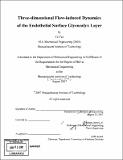Three-dimensional flow-induced dynamics of the endothelial surface glycocalyx layer
Author(s)
Yao, Yu, Ph. D. Massachusetts Institute of Technology
DownloadFull printable version (15.29Mb)
Alternative title
3D flow-induced dynamics of the endothelial surface glycocalyx layer
Other Contributors
Massachusetts Institute of Technology. Dept. of Mechanical Engineering.
Advisor
C. Forbes Dewey, Jr.
Terms of use
Metadata
Show full item recordAbstract
Endothelial cells play a central role in maintaining vascular integrity. Lesions in the endothelial layer may allow the invasion of leukocytes into the artery wall and promote inflammatory responses that could possibly lead to atherosclerosis. Over the past decade, a series of studies have demonstrated the presence of a delicate surface layer, named the glycocalyx, decorating the endothelial membrane and associated with a number of physiological implications in the vasculature. This thesis studies the flow-induced dynamics of the endothelial glycocalyx layer and reports the first direct measurement of the in vitro mechanical properties as well as the thickness of the glycocalyx through a novel optical imaging approach. Here, we have developed an optical imaging system that tracks the position of single particles in three-dimensional (3D) space with high precision, typically 1~4 nm in the XY plane and 15 ~ 40nm in the Z-direction along the optical axis of the microscope. With the use of quantum dots (QDs), semiconducting nanoparticles of superior optical characteristics, this method provides the opportunity to investigate biological subjects in living cells that can be neither spatially resolved nor continuously traced over minutes by conventional optical microscopy techniques. Therefore, by 3D mapping of both the glycocalyx layer and the membrane using quantum dots of different colors, the in vitro thickness of the endothelial glycocalyx layer is found to be - 350nm. With QDs attached to the glycocalyx layer, we track the flow-induced motion of this thin structure at multiple levels of oscillating shear stresses from 5 to 20 dynes/cm2. The displacement of each QD ranges from 80 - 400 nm and varies from cell to cell and point to point on a single cell. (cont.) The estimated Young's modulus is thus~6.7Pa, for a 3D matrix with a measured thickness of ~ 350nm. The QD motion, staying in phase with the applied shear stress up to the 1Hz limit of the present study, confirms the highly elastic gel nature for the glycocalyx layer in which major deformations occur at physiological level of fluid shear stress.
Description
Thesis (Ph. D.)--Massachusetts Institute of Technology, Dept. of Mechanical Engineering, 2007. Includes bibliographical references (p. 157-166).
Date issued
2007Department
Massachusetts Institute of Technology. Department of Mechanical EngineeringPublisher
Massachusetts Institute of Technology
Keywords
Mechanical Engineering.